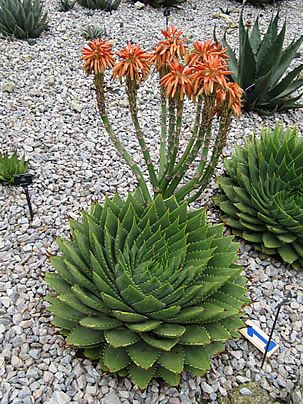With its hypnotic effect, the Spiral Aloe (Aloe polyphylla) resembles a mandala. Its leaves are mathematically arranged in a symmetrical spiral, captivating observers and making them marvel at nature’s perfection. This succulent is native to the mountainous Drakensberg Range in the Kingdom of Lesotho, a small country entirely surrounded by South Africa. For decades, this species was threatened by collectors, pushing it towards extinction. Nowadays, due to the plant’s appeal, many nursery growers are dedicated to propagating it, a challenging task.
The Spiral Aloe is a stemless plant with long, thick roots and rapid growth, reaching adult size in 5 to 6 years after planting. In the first two years, its leaves are erect, in a rosette, like a common succulent, and then it begins to spiral, either clockwise or counterclockwise, acquiring the species’ distinctive appearance. An adult plant can have up to five lines of spiraling leaves from the center.
Its leaves have thorns on the edges, are densely arranged, and are covered with a wax that gives them a gray-blue color, especially under full sun. This species does not produce lateral shoots. When mature and under certain conditions, it produces a strong floral stalk above the foliage, with branched inflorescence and tubular flowers in salmon, pink, or, more rarely, yellow. Flowering occurs in spring and summer. Cross-pollination is necessary for the formation of fertile seeds.

A jewel in the eyes of many cactus and succulent collectors, the Spiral Aloe is considered a “must-have” by many. Besides being a highlight of collections, it can be used in succulent gardens, desert-inspired or rocky gardens. Its exotic appearance is further enhanced when planted with contrasting colored gravel in landscaping.
It can be planted directly in the ground or in pots and planters. Despite its appearance, this is not a desert succulent, and it requires slightly more water than other succulent plants. Nonetheless, it is quite resistant to short periods of drought.
It should be grown in full sun, in mild climates, or partial shade, in hot climates. It’s crucial that the substrate is well-draining and aerated, so the plant never becomes waterlogged and the roots stay well-oxygenated. Therefore, using a saucer under the pot is almost a crime. Water the plant allowing the substrate to dry between watering.
It prefers a mild climate with cool nights. Thus, avoid using pots that retain heat, like ceramic or dark-colored ones. It’s tolerant of subtropical cold. Propagation is by seeding. The seeds have dormancy and can take from weeks to months to germinate. Meristematic micropropagation is a commercially viable option.


